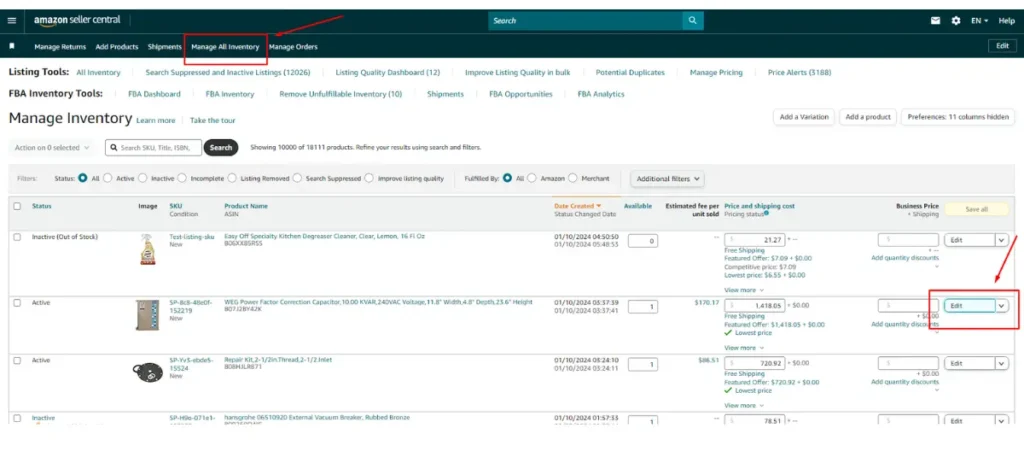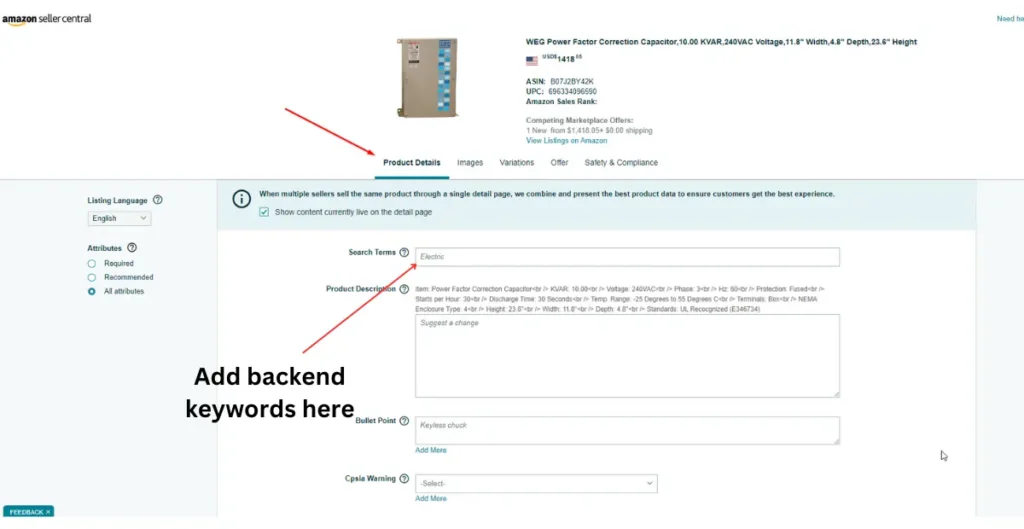Amazon backend keywords are a vital yet often overlooked aspect of successful Amazon selling. They act as the backbone of your product’s SEO strategy, working behind the scenes to increase visibility and drive sales.
Unlike the keywords and phrases that customers see in your product titles and descriptions, backend keywords are hidden, specifically designed to interact with Amazon’s search algorithm.
But how do these unseen keywords make a significant impact on your product rankings? And what strategies can you implement to leverage them effectively?
In this guide, we’ll delve into the intricacies of Amazon backend keywords, exploring their role and importance in boosting your product’s placement in search results.
What Are Amazon Backend Keywords?
Amazon backend keywords, often referred to as “search terms” in the Amazon seller community, are a set of words or phrases that sellers can use to optimize their product listings.
These keywords are not visible to customers browsing through Amazon but play a pivotal role in how Amazon’s search algorithm indexes and ranks products.
Essentially, backend keywords are akin to the metadata of a product listing. They are used to inform Amazon’s search engine about the context and content of a product, helping it appear in relevant search queries.
Unlike the keywords and phrases that customers can see in product titles, bullet points, and descriptions, backend keywords are hidden and exclusively used for search indexing purposes.
The primary function of these keywords is to capture the variety of ways potential customers might search for products. This includes synonyms, abbreviations, alternate names, and related terms that a customer might use to find products similar to yours.
For example, for a “water bottle,” relevant backend keywords could include “reusable bottle,” “sports flask,” or “drink container.”
Backend keywords are crucial because they allow sellers to target additional search terms without cluttering their visible product listing with an excessive amount of keywords.
This helps in keeping the product descriptions customer-friendly while still being optimized for Amazon’s search algorithm. The strategic use of these keywords can significantly impact a product’s discoverability and, consequently, its sales and success on the platform.
Why Backend Keywords Matter in Amazon SEO
In the dynamic and competitive world of Amazon, where millions of products vie for attention, backend keywords emerge as a critical element for success in Amazon Search Engine Optimization (SEO).
They play a key role in influencing a product’s visibility and ranking on the platform. Here’s why backend keywords are indispensable in Amazon SEO:
Enhancing Product Discoverability
Amazon’s search algorithm relies heavily on keywords to index and display products in response to a customer’s query.
Amazon backend keywords enable sellers to target additional search terms that might not be feasible to include in the visible listing. This broadens the reach of the product to potential customers who might use a variety of terms to search for items they wish to purchase.
Bridging the Search Intent Gap
Customers often use different terms or phrases to search for the same product. Amazon backend keywords help bridge this gap by allowing sellers to include synonyms, related terms, and even common misspellings.
This alignment with diverse customer search behaviors increases the chances of a product appearing in search results, catering to a wider audience.
Improving Ranking without Compromising Quality
One of the challenges in Amazon SEO is maintaining a balance between keyword optimization and the quality of the content.
Amazon backend keywords offer a solution by allowing sellers to optimize for search terms without overstuffing the visible content, thus maintaining the quality and readability of the product listing.
Targeting Niche Markets
Amazon backend keywords are particularly useful for targeting niche segments. Sellers can include specific terms that may be relevant to a smaller, more focused group of customers.
This targeted approach can lead to higher conversion rates as the product matches closely with what the customer is searching for.
Competing Effectively
In a marketplace as vast as Amazon, standing out is crucial. Backend keywords give sellers an edge, allowing them to compete effectively with similar products.
By using well-researched and strategic Amazon backend keywords, sellers can increase their product’s visibility even in highly saturated market segments.
Adapting to Amazon’s Evolving Algorithm
Amazon’s algorithm continuously evolves, and backend keywords offer the flexibility to adapt to these changes.
Regularly updating and refining Amazon backend keywords based on performance data and market trends ensures ongoing relevance and alignment with the algorithm’s criteria.
Best Practices for Amazon Backend Keywords
Effectively leveraging backend keywords on Amazon requires adherence to a set of best practices.
These guidelines are designed to maximize the impact of your keywords within the constraints of Amazon’s system.
1. Utilizing the 250-Byte Limit Effectively
Amazon limits backend keywords to 250 bytes, including spaces and punctuation. This constraint necessitates a strategic approach to keyword selection.
Focus on the most relevant and impactful keywords, ensuring every byte contributes to your product’s discoverability.
Avoid redundancy; do not repeat words already present in your product title or bullet points, as Amazon’s algorithm automatically accounts for these. The goal is to complement, not duplicate, your visible content.
2. Incorporating Variations and Synonyms
Expanding your keyword range to include synonyms and variations is a smart move. This broadens your product’s reach to customers who may use different terms for similar items.
Incorporate common misspellings if they are likely to be used by potential customers, but be cautious not to overdo it. The focus should remain on relevant, search-friendly terms that genuinely relate to your product.
3. Avoiding Prohibited Practices
Adhering to Amazon’s guidelines is crucial. Avoid including misleading or irrelevant keywords, as this can negatively impact the customer experience and your product’s performance.
Keyword stuffing, or the practice of cramming as many keywords as possible into your backend fields, is also frowned upon. Such tactics can lead to penalties from Amazon, including decreased product visibility.
4. Regularly Review and Update Keywords
The Amazon marketplace is dynamic, making regular reviews and updates of your backend keywords essential. Monitor their performance, utilizing data and insights to refine and adjust your strategy.
Stay attuned to changing trends, seasonal shifts, and evolving customer behaviors to ensure your keywords remain effective and relevant.
5. Keyword Research Tools and Techniques
Employ various tools and techniques for comprehensive keyword research. Tools like Google Keyword Planner, Helium 10, or Ahrefs offer valuable insights into popular and effective search terms.
Additionally, consider analyzing the keyword strategies of top-performing competitors in your category. This can provide a benchmark and inspire your own keyword choices.
6. Localizing Keywords for Different Markets
For sellers operating in multiple geographical markets, localizing Amazon backend keywords is vital. Tailor your keywords to align with local languages, cultural nuances, and specific search behaviors.
This approach ensures your product resonates with each unique customer base.
7. Using Backend Keywords for Product Variations
If your product comes in various forms (different sizes, colors, etc.), it’s wise to use variation-specific Amazon backend keywords. This allows each product variation to be uniquely optimized, increasing the chances of matching with relevant customer searches.
By meticulously applying these best practices, you can significantly enhance your product’s visibility on Amazon.
Remember, Amazon backend keywords are a crucial component of your overall SEO strategy, and their effective management can lead to improved rankings, greater visibility, and ultimately, increased sales.
Step-by-Step Guide to Adding Amazon Backend Keywords
Adding backend keywords to your Amazon product listings is a straightforward process, but it requires attention to detail to ensure maximum effectiveness.
Here’s a step-by-step guide to help you navigate through this process:
Step 1: Log in to Your Amazon Seller Central Account. Begin by logging into your Amazon Seller Central account. This is your dashboard for managing all aspects of your Amazon sales.
Step 2: Navigate to Your Product Listings. Go to the ‘Inventory’ tab and select ‘Manage All Inventory.’ From here, choose the product listing you want to add backend keywords to.

Step 3: Enter Edit Mode for the Selected Product. Click on the ‘Edit’ button next to the product listing. This will take you to the detail page where you can modify various aspects of your listing.
Step 4: Add Backend Keywords. In the ‘Product Details’ page navigate to ‘Search Terms’. This is where you input your backend keywords.

Step 5: Save Your Updates: After entering your keywords, ensure that you save your changes. This will update your product listing with the new backend keywords.
Step 6: Regularly Monitor and Revise: Adding backend keywords is not a one-time task. Regularly monitor the performance of your listing in relation to these keywords.
Based on performance data, you may need to revise and update your keywords to maintain optimal search relevance and ranking.
Conclusion
The journey toward mastering Amazon backend keywords requires a blend of strategic thinking, ongoing optimization, and adaptability to changing market trends.
The ultimate goal is to connect your products with the customers searching for them, which effectively demands both insight and finesse.
As the Amazon marketplace continues to evolve, staying informed and adaptable in your SEO strategies will be key to staying ahead.
By applying the insights and strategies discussed, you’re well on your way to enhancing your product rankings, improving visibility, and ultimately driving more sales and growing your Amazon business.
In conclusion, Amazon backend keywords may be unseen, but their impact is unmistakable. They are the silent champions of search optimization, subtly guiding customers to your products.
Embrace these strategies, refine them to fit your unique products and market niche, and watch as your Amazon listings rise to new heights of success.







